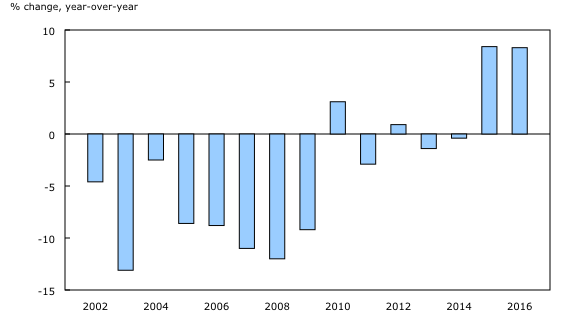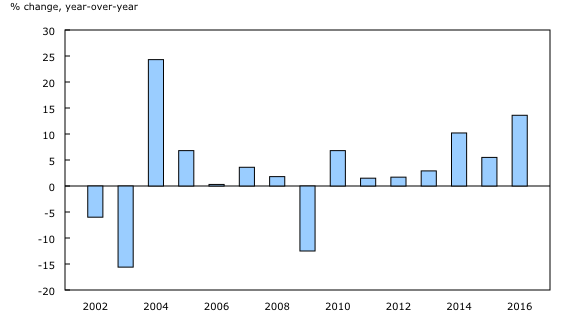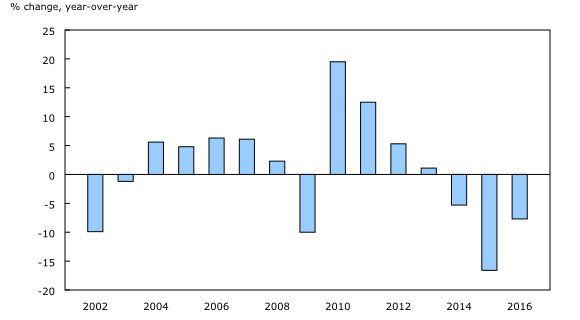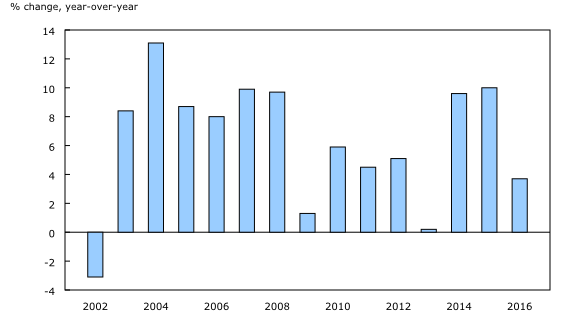Travel between Canada and other countries, December 2016
Archived Content
Information identified as archived is provided for reference, research or recordkeeping purposes. It is not subject to the Government of Canada Web Standards and has not been altered or updated since it was archived. Please "contact us" to request a format other than those available.
Released: 2017-02-21
Residents of overseas countries (countries other than the United States) made 551,000 trips to Canada in December, up 1.4% from November.
Travel by residents of Mexico rose 36.5% from the previous month, as the visa requirement for travellers from Mexico to Canada was lifted on December 1, 2016, and additional flights from Mexico to Canada were introduced by airline companies.
Travel by Canadian residents to overseas countries also increased in December, rising 1.1% from November to 1.0 million trips.
US residents made 2.0 million trips to Canada in December, down 2.7% from November. Both overnight travel (-3.1%) and same-day car travel (-2.7%) declined.
Episodes of severe weather that led to highway closures and flight cancellations in December contributed to notable decreases in cross-border traffic in Manitoba and Saskatchewan. Travel by US residents to Manitoba (-18.7%) and Saskatchewan (-12.5%) were down in December.
Canadian residents made 3.3 million trips to the United States in December, down 1.4% compared with the previous month.
Year-end review, 2016
The following analysis focuses on 2016 annual totals and comparisons with previous years.
The number of travellers from abroad making trips to Canada increased 9.4% from 2015 to 30.1 million in 2016, the highest number of travellers to Canada since the global recession of 2008-2009. The annual gain in 2016 was also the strongest since the recession.
The increase in 2016 was the result of an 8.3% gain in US travellers and a 13.6% increase in overseas travellers to Canada.
In 2016, travel from Canada to the United States declined for the third year in a row, down 7.7% from 2015, reflecting the decline in the Canadian dollar over this period. Despite the drop, the United States remained the top international destination for Canadians, accounting for three-quarters of Canadian trips abroad.
Travel to overseas destinations rose in popularity in 2016, as Canadians made 3.7% more trips to overseas countries.
Air travel growing for US travellers to Canada
In 2016, four out of five travellers to Canada from abroad came from the United States. With the United States experiencing the combination of a healthy economy and a strong dollar, the number of US travellers to Canada rose 8.3% from 2015 to 23.9 million in 2016. The gain in 2016 was similar to the 8.4% increase of the previous year, but in contrast to the declines or small increases in the numbers of US travellers that characterized the preceding 15 years.
Travel by plane accounted for a relatively small share—one in five—of US trips to Canada in 2016. However, the number of US travellers who came to Canada by plane was up 15.9% to 5.3 million, outpacing growth in travel by car from the United States, which rose 6.9% to 16.3 million trips.
Strong growth in overseas travel to Canada
Canada welcomed a record 6.2 million overseas travellers in 2016, up 13.6% from 2015. This was the seventh consecutive annual increase and the strongest annual gain since 2004, when overseas travel to Canada was recovering from the impact of the SARS (severe acute respiratory syndrome) outbreak of 2003.
Growth in overseas travel to Canada in 2016 came from many regions. It included a 15.6% year-over-year increase in travellers from Asia (2.1 million trips), and a 12.7% gain in travellers from Europe (2.9 million trips).
The number of travellers from China has tripled since 2010, and in 2015 it became Canada's second largest source of overseas travellers after the United Kingdom. In 2016, travellers from China took 625,000 trips to Canada, up 22.2% from 2015.
Travel to Canada from other Asian countries also increased in 2016. The number of Japanese travellers rose 9.3% from 2015 to 322,000, while travel from South Korea grew 24.4% to 255,000 trips. Gains were also recorded for travel from India, up 12.5% to 225,000 trips, and Taiwan, up 34.8% to 103,000 trips.
The United Kingdom led travel from Europe to Canada in 2016, with the number of UK travellers up 16.0% from 2015 to 851,000. France was the second largest source of European travellers to Canada, up 8.8% to 552,000, followed by Germany, up 11.1% to 382,000.
The number of Australians travelling to Canada also rose in 2016, up 14.7% from 2015 to 352,000, while travel from Mexico rose 23.2% to 252,000 trips.
Fewer trips to the United States
Travel from Canada to the United States declined for the third consecutive year in 2016, down 7.7% to 41.0 million trips. The decrease in 2016 was mainly attributable to a 9.0% reduction in the number of Canadian car trips to the United States, while air travel by Canadian residents to the United States declined 1.9%.
Since 2013, when the Canadian dollar was last at par with the US dollar, the number of Canadians travelling to the United States by car has fallen by 31.3%, from 46.4 million in 2013 to 31.8 million in 2016.
Growth in Canadian travel to overseas destinations slows
The number of Canadians travelling overseas continued to increase in 2016, rising 3.7% to 12.0 million. This followed annual increases of 9.6% in 2014 and 10.0% in 2015.
The number of Canadians travelling overseas has risen every year since 1992, except in 2002, the year following the September 11 terrorist attacks. Unlike travel to the United States that peaks in the summer months of July and August, the numbers of Canadians travelling overseas—as counted by the date they return to Canada—traditionally peaks in the winter months of January and March.
Note to readers
Monthly data are seasonally adjusted. For information on seasonal adjustment, see Seasonally adjusted data – Frequently asked questions.
Seasonally adjusted data for January to November of 2016 have been revised.
Overseas countries refer to countries other than the United States.
A Canadian resident traveller is a Canadian resident who has travelled outside Canada for a period of less than 12 months.
A non-resident traveller is a resident of a country other than Canada who is travelling to Canada for a period of less than 12 months.
Products
The December 2016 issue of International Travel: Advance Information, Vol. 32, no. 12 (66-001-P), is now available.
Contact information
For more information, or to enquire about the concepts, methods or data quality of this release, contact us (toll-free 1-800-263-1136; 514-283-8300; STATCAN.infostats-infostats.STATCAN@canada.ca) or Media Relations (613-951-4636; STATCAN.mediahotline-ligneinfomedias.STATCAN@canada.ca).
- Date modified:






